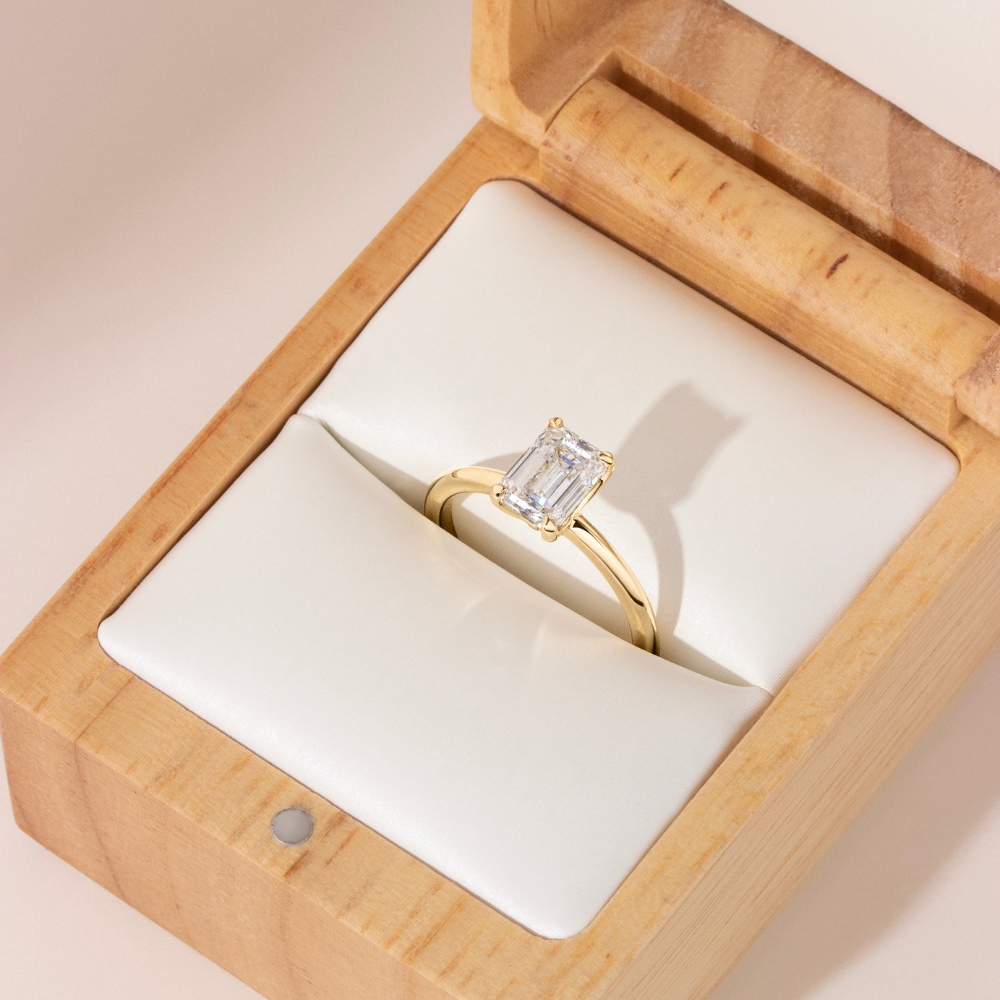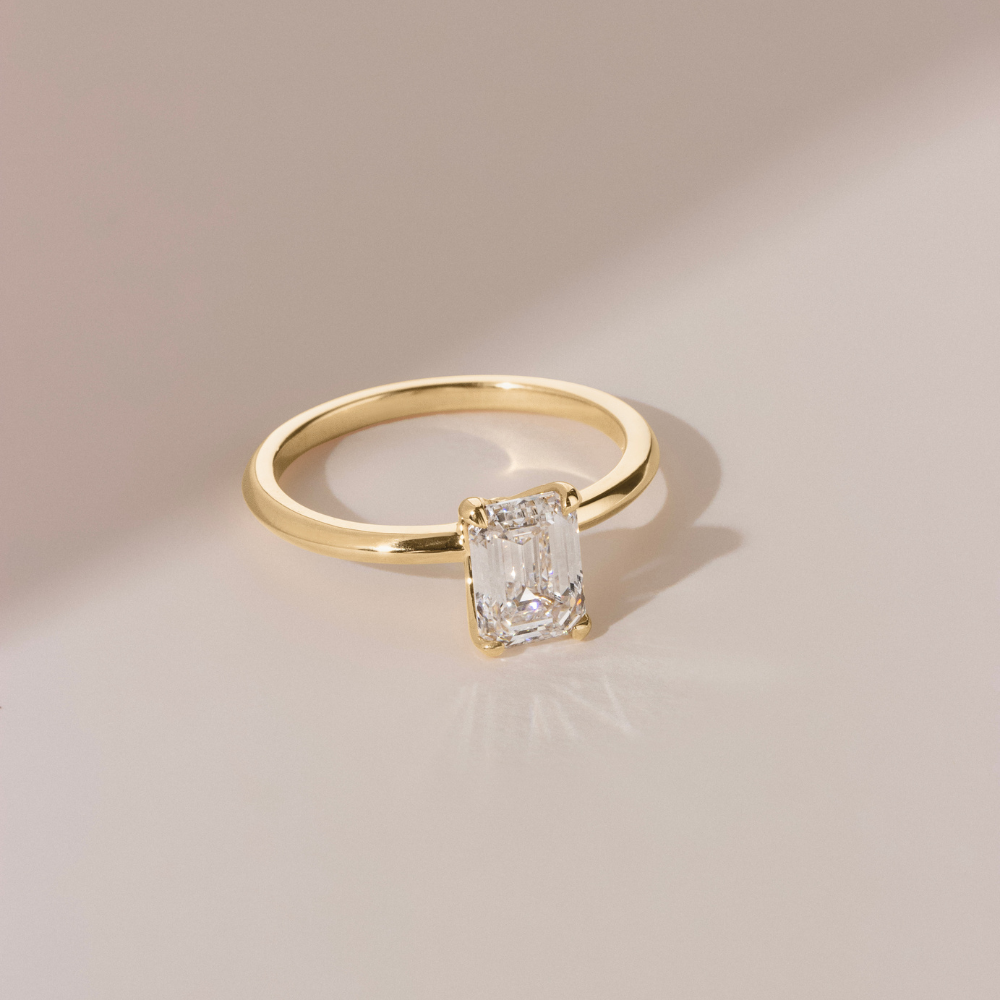
Diamonds are cherished for their brilliance and durability, but even the most sparkling diamond ring can lose its luster over time due to dirt, oil, and other residues. Proper cleaning is essential to maintain the beauty of your diamond ring. This guide will provide you with detailed instructions on how to clean your diamond ring effectively and safely at home.
How often should you clean your diamond ring?
Ideally, you should clean your diamond ring at home as needed. Routine cleanings help prevent the buildup of oils, lotions, and everyday dirt that can dull its sparkle. Additionally, it’s advisable to have your ring professionally deep cleaned and inspected by a jeweler once or twice a year. Professional cleanings ensure that the ring is thoroughly cleaned and that the setting is secure, preventing potential loss of the diamond. If you own a Brilliant Earth ring, you can get complimentary ring cleanings from one of our jewelry experts at any of our showrooms.

How to Clean a Diamond Ring
Cleaning a diamond ring at home can be simple and effective with the right approach. Follow these steps to ensure your ring remains radiant.
Materials Needed
- Mild dish soap
- Warm water
- Soft-bristled toothbrush
- Soft, lint-free cloth or microfiber cloth
- Small bowl
The Step-by-Step Cleaning Process
- Prepare the Cleaning Solution: Mix a few drops of mild dish soap with warm water in a small bowl. Avoid using harsh chemicals or household cleaners as they can damage the metal or loosen the stone.
- Soak the Ring: Place your diamond ring in the solution and let it soak for about 20 to 40 minutes. Soaking helps to loosen dirt and grime from the diamond and the setting.
- Brush Gently: Using a soft-bristled toothbrush, gently scrub the diamond and the setting. Pay special attention to the back of the diamond, where dirt tends to accumulate. Use gentle, circular motions to avoid scratching the metal.
- Rinse Thoroughly: Rinse the ring under warm running water to remove any soap residue. Make sure to plug the drain or use a strainer to prevent the ring from accidentally falling down the sink.
- Dry Carefully: Pat the ring dry with a soft, lint-free cloth or microfiber cloth. Avoid using paper towels or tissues as they can scratch the metal or leave fibers behind.
There are a few other methods for cleaning a diamond ring that include materials like Windex, hydrogen peroxide, jewelry cleaner solution, vinegar, baking soda, and even ketchup or beer—but these methods only work for specific types of metals, whereas the process and materials listed above work for any metal type. Another option is to use our cleaner pens, which are provided with select purchases but gentle enough to use on any of your jewelry pieces. Our pens are filled with a gentle, mild solution, and have a brush tip for getting hard-to-reach places.
We recommend using soap and water or one of our cleaner pens to ensure you’re using the safest method to care for your jewelry. By following these steps, you can maintain the sparkle and brilliance of your diamond ring, ensuring it remains a stunning symbol of your relationship.

What to Avoid When You’re Cleaning a Diamond Ring at Home
While cleaning your diamond ring at home is generally safe, there are certain practices and substances you should avoid to prevent damage, including:
- Harsh Chemicals: Avoid using bleach, chlorine, acetone, or other harsh chemicals. These can weaken the metal setting and dull the appearance of the diamond.
- Abrasive Materials: Steer clear of abrasive cleaners or scrubbers, such as baking soda or toothpaste. These substances can scratch the metal and damage the diamond.
- Ultrasonic Cleaners: While ultrasonic cleaners can be effective, they are best used under the guidance of a professional jeweler. The intense vibrations can loosen stones, especially in older rings or those with intricate settings.
- Commercial Jewelry Cleaners: If you choose to use a commercial jewelry cleaner, ensure it is specifically formulated for diamonds and follow the manufacturer’s instructions carefully.
Maintaining the brilliance of your diamond ring involves regular, gentle cleaning using mild soap and water. Avoiding harsh chemicals and abrasive materials is key to preserving the ring’s beauty and integrity. With proper care, your diamond ring will continue to shine brightly, symbolizing your enduring love and commitment.
Interested in learning more about diamonds? Check out our other Diamond Guides: Diamond Cut, Diamond Clarity, Diamond Carat, Diamond Color, Diamond Shape, Lab Grown Diamonds, Moissanite vs. Diamond, Moissanite vs. Lab Diamond, Cubic Zirconia vs. Lab Diamond, How Are Lab Grown Diamonds Made?, MM to Carat




